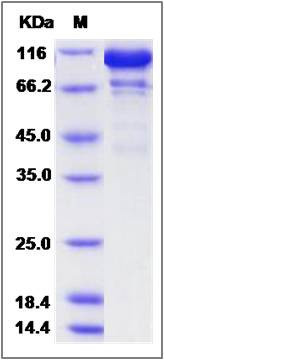Mouse CD45 / PTPRC Protein (aa 453-1152, His & GST Tag)
B220,Cd45,CD45R,L-CA,loc,Ly-5,Lyt-4,T200
- 100ug (NPP3234) Please inquiry
| Catalog Number | P50713-M20B |
|---|---|
| Organism Species | Mouse |
| Host | Baculovirus-Insect Cells |
| Synonyms | B220,Cd45,CD45R,L-CA,loc,Ly-5,Lyt-4,T200 |
| Molecular Weight | The recombinant mouse PTPRC/GST chimera consists of 937 amino acids and has a calculated molecular mass of 108.2 kDa. The recombinant protein migrates as an approximately 110 kDa band in SDS-PAGE under reducing conditions. |
| predicted N | Met |
| SDS-PAGE |  |
| Purity | > 95 % as determined by SDS-PAGE |
| Protein Construction | A DNA sequence encoding the mouse PTPRC (Arg453-Ser1152) was fused with the N-terminal polyhistidine-tagged GST tag at the N-terminus. |
| Bio-activity | 1. The specific activity was determined to be 12306 nmol/min/mg using p-nitrophenyl phosphate as substrate. 2. Measured by its ability to bind biotinylated Galectin-1 (P10290-HNAE-E) in a functional ELISA. |
| Research Area | Cancer |Signal transduction |Phosphatase & Regulator |Phosphatase Regulator |
| Formulation | Supplied as sterile 20mM Tris, 500mM NaCl, 0.5mM GSH, 3mM DTT, pH 7.4, 10% gly 1. Normally 5 % - 8 % trehalose, mannitol and 0.01% Tween80 are added as protectants before lyophilization. Specific concentrations are included in the hardcopy of COA. |
| Background | The cluster of differentiation (CD) system is commonly used as cell markers in immunophynotyping. Different kinds of cells in the immune system can be identified through the surface CD molecules which associating with the immune function of the cell. There are more than 320 CD unique clusters and subclusters have been identified. Some of the CD molecules serve as receptors or ligands important to the cell through initiating a signal cascade which then alter the behavior of the cell. Some CD proteins do not take part in cell signal process but have other functions such as cell adhesion. Protein tyrosine phosphatase, receptor type C (CD45), also known as PTPRC is a member of the protein tyrosine phosphatase (PTP) family which is known for its function to serve as signaling molecules and to regulate a variety of cellular processes such as cell proliferation, differentiation, mitotic cycle and oncogenic transformation. CD45 is found expression specifically in hemotopietic cells. CD45 consists of an extracellular domain, a single transmembrane segment and two tandem intracytoplasmic catalytic domains. It serves as an essential regulator of T-cell and B-cell antigen receptor signaling through either direct interaction with components of the antigen receptor complexs or by activating various Src family kinases required for the antigen receptor signaling and it also can suppress JAK kinases. |
| Reference |
